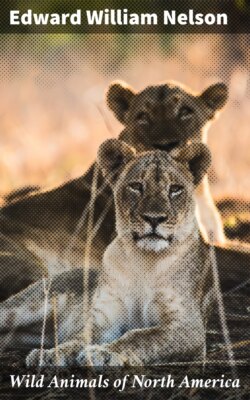Читать книгу Wild Animals of North America - Edward William Nelson - Страница 19
На сайте Литреса книга снята с продажи.
CANADA LYNX (Lynx canadensis)
ОглавлениеTable of Contents
The lynxes are long-legged, short-bodied cats, with tufted ears and a short “bobbed” tail. They are distributed from the northern limit of trees south into the Temperate Zone throughout most of the northern part of both Old and New Worlds. In North America there are two types—the smaller animal, southern in distribution, and the larger, or Canada lynx, limited to the north, where its range extends from the northern limit of trees south to the northern border of the United States. It once occupied all the mountains of New England and south in the Alleghenies to Pennsylvania. In the West it is still a habitant of the Rocky Mountains as far south as Colorado, and of the Sierra Nevada nearly to Mount Whitney.
The Canada lynx is notable for the beauty of its head, one of the most striking among all our carnivores. This species is not only much larger than its southern neighbor, the bay lynx, but may also be distinguished from it by its long ear tips, thick legs, broad spreading feet, and the complete jet-black end of the tail. It is about 3 feet long and weighs from 15 to over 30 pounds. As befits an animal of the great northern forests, it has a long thick coat of fur, which gives it a remarkably fluffy appearance. Its feet in winter are heavily furred above and below and are so broad that they serve admirably for support in deep snow, through which it would otherwise have to wade laboriously.
This animal does not attack people, though popular belief often credits it with such action. It feeds mainly on such small prey as varying hares, mice, squirrels, foxes, and the grouse and other birds living in its domain; but on occasion it even kills animals as large as mountain sheep. One such feat was actually witnessed above timberline in winter on a spur of Mount McKinley. The lynx sprang from a ledge as the sheep passed below, and, holding on the sheep’s neck and shoulders, it reached forward and by repeatedly biting put out its victim’s eyes, thus reducing it to helplessness.
The chief food of the Canada lynx is the varying hare, which throughout the North periodically increases to the greatest abundance and holds its numbers for several years. During these periods the fur sales in the London market show that the number of lynx skins received increases proportionately with those of the hare. When an epizoötic disease appears, as it does regularly, and almost exterminates the hares, there is an immediate and corresponding drop in the number of lynx skins sent to market. This evidences one of Nature’s great tragedies, not only among the overabundant hares, but among the lynxes, for with the failure of their food supply over a vast area tens of thousands of them perish of starvation.
The Canada lynx has from two to five kittens, which are marked with dusky spots and short bands, indicating an ancestral relationship to animals similar to the ocelot, or tiger-cat, of the American tropics. The young usually keep with the mother for nearly a year. Such families no doubt form the hunting parties whose rabbit drives on the Yukon Islands were described to me by the fur traders and Indians of the Yukon Valley.
During sledge trips along the lower Yukon I often saw the distinctive broad, rounded tracks of lynxes, showing where they had wandered through the forests or crossed the wide, snow-covered river channel. Here and there, as the snow became very deep and soft, the tracks showed where a series of leaps had been made. Lynx trails commonly led from thicket to thicket where hares, grouse, or other game might occur. Canada lynxes appear to be rather stupid animals, for they are readily caught in traps, or even in snares, and, like most cats, make little effort to escape.
